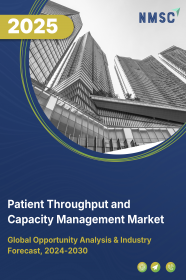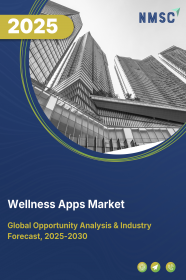
Patient Throughput and Capacity Management Market by Product Type (Workflow Management Solutions, Asset Management Solutions, Bed Management Solutions, Quality Patient Care Solutions, Real Time Locating System (RTLS), and Event Driven Solutions), by Solution Type (Standalone and Integrated), and by Delivery Mode (On-Premise and Cloud- Based), and by Application (Bed Management, Nursing and Staff Scheduling, and Others) – Global Opportunity Analysis and Industry Forecast 2025-2030
US Tariff Impact on Patient Throughput and Capacity Management Market
Trump Tariffs Are Reshaping Global Business
Patient Throughput and Capacity Management Market Overview
The global Patient Throughput and Capacity Management Market size was valued at USD 1.26 trillion in 2024 and is predicted to reach USD 1.69 trillion by 2030 with a CAGR of 4.9% from 2025-2030. The market is driven by the surging demand for healthcare services due to an aging population and rising chronic illnesses, necessitating efficient patient flow to prevent overcrowding, long wait times, and compromised care quality.
The need to optimize operational efficiency and reduce costs under financial pressures further propels the market growth, as effective capacity management tools enhance bed utilization and minimize delays. Additionally, the focus on patient-centric care and improved clinical outcomes fuels demand for solutions that streamline patient journeys and boost satisfaction.
However, limited hospital beds and staffing shortages, exacerbated by events like the COVID-19 pandemic, pose significant challenges to optimizing throughput. A key opportunity lies in developing integrated capacity management platforms that offer real-time visibility, predictive analytics, and automated coordination to improve patient flow, reduce costs, and enhance care quality, driving market expansion.
Soaring Demand for Healthcare Services Fuels the Need for Efficient Throughput
The patient throughput and capacity management market demand is significantly propelled by the ever-increasing demand for healthcare services. This surge is driven by a confluence of factors, notably an ageing global population requiring more frequent and complex medical care, and the rising prevalence of chronic illnesses. As healthcare systems grapple with higher patient volumes, the imperative to manage this demand efficiently becomes paramount.
Without effective patient flow and capacity management strategies, healthcare facilities risk becoming overwhelmed, leading to longer wait times, compromised quality of care, and increased operational costs.
For instance, emergency departments (EDs) globally are facing overcrowding due to rising demand, highlighting the critical need for solutions that can optimise patient movement and resource allocation across the entire health system. This escalating demand underscores the substantial growth potential within the patient throughput and capacity management industry size.
The Need for Optimizing Healthcare Operations Drives the Market Growth
A crucial market driver for patient flow management solutions is the persistent pressure on healthcare organisations to enhance operational efficiency and simultaneously curtail escalating costs.
In today's challenging economic climate, health systems are under immense financial duress. Inefficient patient flow contributes significantly to higher operational costs through factors like extended patient stays, underutilisation of resources, and bottlenecks that disrupt schedules and workflows.
By implementing effective capacity management tools and strategies, hospitals and clinics can optimise bed utilisation, reduce unnecessary delays, and improve the overall efficiency of their operations. For example, real-time insights into patient demand and bed availability enable administrators to monitor and adjust resource allocation proactively, thereby minimising bottlenecks and reducing operational costs.
The potential for significant financial upside through improved bed management systems make this a key area of focus for healthcare executives, driving the patient throughput and capacity market trends and increasing the market share of effective solutions within the broader healthcare industry size.
Driving Improvements in Experience and Outcomes Propels the Growth of the Market
The growing emphasis on delivering patient-centric care and achieving better clinical outcomes acts as another significant driver of the patient throughput and capacity management market growth. Healthcare organisations increasingly recognise that efficient patient flow is intrinsically linked to both patient satisfaction and the quality of care provided.
Delays and bottlenecks in the patient journey can lead to frustration, anxiety, and potentially adverse outcomes. Conversely, streamlined processes, timely access to care, and effective coordination contribute to a positive patient experience and improved health outcomes. For instance, mapping patient care journeys and identifying bottlenecks can lead to agreed-upon initiatives that improve efficiency and patient experience.
Moreover, ensuring patients receive the right care, in the right place, at the right time, with the right resources is a core tenet of improving both throughput and outcomes. This focus on patient-centricity and quality of care fuels the demand for solutions that optimise the patient journey, contributing to the growth potential of the market size and share of effective patient throughput and capacity management technologies and strategies.
Navigating Limitations in Beds and Staff Hinders the Market Growth
A significant restraint on the patient throughput and capacity management market expansion, despite its growth potential, is the pervasive issue of limited resources within healthcare systems. This encompasses both a scarcity of available hospital beds and a shortage of human resources, including physicians, nurses, and support staff.
The COVID-19 pandemic further exacerbated these limitations, placing immense pressure on healthcare capacity. Limited bed availability can lead to ED overcrowding, prolonged waiting times for admissions, and cancellations of elective procedures, all of which negatively impact patient flow.
Similarly, shortages in staffing can strain existing resources, hinder the implementation of new patient throughput initiatives, and contribute to staff burnout. Addressing these fundamental resource constraints requires systemic changes and innovative solutions within the industry size, but they currently pose a considerable challenge to optimising capacity and patient flow effectively across the market.
Integrated Solutions Capacity Management Solutions Presents Lucrative Opportunity for Market Growth
A key market opportunity for industry players within the patient throughput and capacity management sector lies in the development and deployment of integrated, comprehensive capacity management solutions.
Rather than relying on disparate tools and manual processes, healthcare organisations are increasingly seeking unified platforms that provide end-to-end visibility and control over patient flow and resource allocation. These integrated solutions can encompass features such as real-time bed management, predictive analytics for demand forecasting, digital tools for care coordination, and automated alerts for potential bottlenecks.
By bringing together these functionalities into a single platform, healthcare providers can gain a much clearer understanding of their operational capacity, make more informed decisions, and ultimately improve patient throughput, reduce costs, and enhance the overall quality of care. The demand for such integrated solutions represents a significant area of growth potential within the expanding market size.
Market Segmentation and Scope of the Study
The patient throughput and capacity management market report is divided on the basis of product type, solution type, delivery mode, application, and region. On the basis of product type, the market is categorised into workflow management solutions, asset management solutions, bed management solutions, quality patient care solutions, real time locating system (RTLS), and event driven solutions. On the basis of solution type, the market is divided into standalone and integrated. On the basis of delivery mode, the market is grouped into on-premise and cloud-based. On the basis of application, the market is divided into bed management, nursing and staff scheduling, patient flow tracking, care coordination tools, and others. Regional breakdown and analysis of each of the aforesaid segments includes regions comprising of Asia-Pacific, North America, Europe, and RoW.
Geographical Analysis
In North America, there is a significant push towards the adoption of AI-powered capacity management solutions. The report from LeanTaaS, focusing on inpatient capacity optimisation, underscores this market trend. Hospitals are actively exploring and implementing technologies to enhance patient flow and optimise resource allocation.
For instance, the discussion around using advanced analytics for capacity management by Mayo Clinic highlights the focus on leveraging data-driven insights to improve efficiency. This region represents a substantial portion of the global patient throughput and capacity market share, driven by the need to improve operational excellence and patient outcomes. The emphasis on data and technology suggests a strong growth potential in this area.
In Europe, a key development is the establishment of hospital capacity command centres (CCCs) as a mechanism to manage patient flow. The benchmarking survey on CCCs provides insights into the motivations, functions, and key performance indicators associated with these centres. The example of Wrightington, Wigan and Leigh Teaching Hospitals NHS Foundation Trust (WWL) in the UK prioritising the digitisation of patient flow to tackle national challenges demonstrates a proactive approach to capacity management in the face of growing demand [The first response].
Furthermore, companies like IQVIA, with a presence in EMEA, are focused on health systems support and patient engagement, indicating the importance of optimising capacity within the European healthcare landscape. Similar to North America, the industry size in Europe is considerable, with the market share being influenced by national healthcare policies and the adoption of innovative technologies to improve hospital efficiency.
The Asia-Pacific region, while not as explicitly detailed in these sources regarding specific case studies, is likely experiencing similar market trends towards digitalisation and improved capacity management. Given the increasing demand for healthcare services in this rapidly growing region, the need for efficient patient throughput solutions is paramount.
Strategies such as implementing digital solutions for real-time visibility of patient journeys and exploring the use of predictive analytics to optimise resource allocation, which are being adopted in North America and Europe, would also hold significant growth potential in the Asia-Pacific industry. The specific approaches and adoption rates may vary based on individual country healthcare infrastructure and investment in technology.
Finally, the Rest of the World encompasses a diverse range of healthcare systems and approaches to patient scheduling software. While specific details for this broad category are not extensively covered in the provided excerpts, the global imperative to enhance healthcare efficiency and patient experience suggests a universal need for effective capacity management strategies.
The fundamental challenges of limited resources and the need for better data integration, as mentioned in the initial overview, are likely to be common across many countries in this segment. Therefore, the market opportunities for developing integrated and comprehensive capacity management solutions and leveraging technologies like AI and machine learning to optimise resource allocation represent significant growth potential for the global industry size as a whole.
Strategic Analysis of the Companies Operating in the Market
Leading players in the global patient throughput and capacity management industry are increasingly adopting digitalisation and innovative technologies to optimise operations. There is a surge in the use of AI-powered capacity management solutions, as highlighted by the report from LeanTaaS on inpatient capacity optimisation. Hospitals are also exploring the establishment of hospital capacity command centres (CCCs) to co-locate teams and leverage real-time data for proactive patient flow management.
For instance, Wrightington, Wigan and Leigh Teaching Hospitals NHS Foundation Trust (WWL) are prioritising the digitisation of patient flow to tackle national challenges and improve care quality amidst growing demands. However, these advancements face challenges such as limited resources, including bed availability and staffing, and the persistent issue of data silos and a lack of seamless interoperability between different healthcare systems.
Looking ahead, significant market opportunities exist in developing integrated, comprehensive capacity management solutions that offer an end-to-end view of the patient journey. Furthermore, leveraging predictive analytics and machine learning to better anticipate demand and optimise resource allocation, as discussed in the Philips Healthcare webinar, presents a substantial growth potential for the industry size and can significantly enhance hospital throughput performance.
Key Benefits
-
The report provides quantitative analysis and estimations of the industry from 2025 to 2030, that assists in identifying the prevailing patient throughput and capacity management market opportunities.
-
The study comprises a deep-dive analysis of the current and future patient throughput and capacity management market trends to depict prevalent investment pockets in the sector.
-
Information related to key drivers, restraints, and opportunities and their impact on the market is provided in the report.
-
Competitive analysis of the players, along with their market share is provided in the report.
-
SWOT analysis and Porters Five Forces model is elaborated in the study.
-
Value chain analysis in the market study provides a clear picture of roles of stakeholders.
Patient Throughput and Capacity Management Market Key Segments
By Product Type
-
Workflow Management Solutions
-
Asset Management Solutions
-
Bed Management Solutions
-
Quality Patient Care Solutions
-
Real Time Locating System (RTLS)
-
Event Driven Solutions
By Solution Type
-
Standalone
-
Integrated
By Delivery Mode
-
On-Premise
-
Cloud- Based
By Application
-
Bed Management
-
Nursing and Staff Scheduling
-
Patient Flow Tracking
-
Care Coordination Tools
-
Others
By Region
-
North America
-
The U.S
-
Canada
-
Mexico
-
-
Europe
-
The UK
-
Germany
-
France
-
Italy
-
Spain
-
Denmark
-
Netherlands
-
Finland
-
Sweden
-
Norway
-
Russia
-
Rest of Europe
-
-
Asia-Pacific
-
China
-
Japan
-
India
-
South Korea
-
Australia
-
Indonesia
-
Singapore
-
Taiwan
-
Thailand
-
Rest of Asia-Pacific
-
-
Rest of the World
-
Latin America
-
Middle East
-
Africa
-
Key Players
-
Epic Systems Corporation
-
Securitas Healthcare LLC
-
CenTrak, Inc.
-
LeanTaaS
-
Care Logistics
-
Veradigm LLC
-
Securitas Healthcare LLC
-
CenTrak, Inc.
-
Navvis & Company, LLC
-
GE HealthCare
-
Mckesson Corporation
-
HealthStream
-
Halma plc
-
NXGN Management, LLC
-
Infinitt Heathcare Co., Ltd.
REPORT SCOPE AND SEGMENTATION:
|
Parameters |
Details |
|
Market Size in 2024 |
USD 1.26 Trillion |
|
Revenue Forecast in 2030 |
USD 1.69 Trillion |
|
Growth Rate |
CAGR of 4.9% from 2025 to 2030 |
|
Analysis Period |
2024–2030 |
|
Base Year Considered |
2024 |
|
Forecast Period |
2025–2030 |
|
Market Size Estimation |
Trillion (USD) |
|
Growth Factors |
|
|
Countries Covered |
28 |
|
Companies Profiled |
15 |
|
Market Share |
Available for 10 companies |
|
Customization Scope |
Free customization (equivalent to up to 80 working hours of analysts) after purchase. Addition or alteration to country, regional, and segment scope. |
|
Pricing and Purchase Options |
Avail customized purchase options to meet your exact research needs. |

















 Speak to Our Analyst
Speak to Our Analyst





















